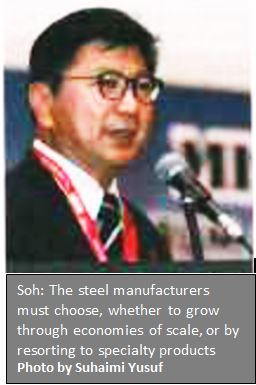Adam Aziz/The Edge Financial Daily October 27, 2017
KUALA LUMPUR: The Malaysian Iron and Steel Industry Federation (Misif) sees a bright future for the local steel industry, thanks to a combination of increasing domestic demand, recovery in product prices and safeguard measures by the authorities.
Misif president Datuk Soh Thian Lai said there is “light at the end of a long tunnel” as market forces are expected to help the prices of steel products normalise upwards in the longer term.
“The industry has improved substantially from two to three years ago,” Soh told reporters at the Malaysian Iron and Steel Industry Trade Forum yesterday.
Local steelmakers have benefited from normalising prices since 2016 after experiencing multi-year low prices in 2015 when Chinese manufacturers resorted to dumping practices amid overcapacity.
“There is still uncertainty from China, which is always a factor. But there has been a scale-down in production over there, and steel prices in the domestic Chinese market have increased enough to reduce their reliance on exports,” said the Misif chief.
The outlook also took into consideration increasing domestic demand from the recent roll-out of key local infrastructure projects. “In this stabilising ecosystem, local manufacturers can respond to local demand and increase production and utilisation rate, which in turn will help lower production cost in future due to economies of scale,” said Soh.
“With growth in the Malaysian economy anticipated at around 5% this year and the next, I would say the demand is there, and the outlook on the steel industry is bright now.”

To grab opportunities from the robust economic environment and increase in local demand, Soh said players must be innovative and decisive.
“The steel manufacturers must choose whether to grow through economies of scale, or by resorting to specialty products.” This includes the manufacturing of higher-margin flat steel products — commonly used in consumer products and vehicles — compared with long products usually used in construction, such as steel concrete reinforcing bars.
As a developing country, Soh said the consumption of long products in Malaysia is still high at around 60%, with the rest taken up by flat products. “It is the other way around in developed countries. In time, you must scale your size and capability to move up the value chain — there is no way around it.
“In this manner, Misif has advocated industry-wide consolidation,” said Soh. “We are also facilitating the local market integration. For one, we are talking to millers who can manufacture high-grade flat products for the automotive industry, and linking them up with local automakers.”
Misif deputy president Datuk Lim Hong Thye, meanwhile, has brushed off claims that the steel levy imposed by the Malaysian government on certain key products — meant to curb underpriced imports or dumping practices — is a major contributing reason for higher steel product prices locally.
On how the steel industry has progressed, Lim said: “Developers were enjoying very good margins two to three years ago, when the Chinese were selling at huge losses. That was not sustainable, and steel prices normalised in 2016.
“This year, domestic steel prices in Malaysia still lag behind China’s domestic prices, as our local demand did not expand quick enough due to the sluggish property market and a slight delay in big infrastructure projects here. But now demand has improved, and our prices are catching up.”
Lim also points out that while steel is a critical component in a building construction, the product take-up is small relative to the overall construction material volume and cost.
“Steel products usually take up between 5% and 10% of the total construction materials used in construction,” said Lim. “A two-storey terrace house takes up less than two tonnes of steel.”
Lim cites rising steel production cost which contributed to the hike. A shortage in supply of graphite electrode — used in electric arc and ladle furnaces — has resulted in rising prices over the last few years. The spot price has increased over 300% to US$35,000 (RM148,050) per tonne since January.
“The price has to move up because of the international trend, it is not an isolated event. Steel is still very much a commodity, and international market forces will also play a part in dictating the price,” Lim said.
